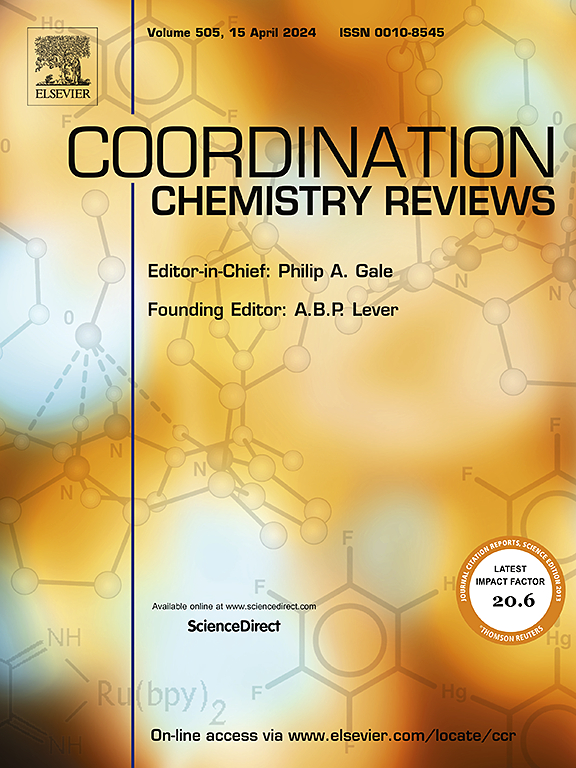二氧化碳捕获的超分子化学
IF 20.3
1区 化学
Q1 CHEMISTRY, INORGANIC & NUCLEAR
引用次数: 0
摘要
全球气候变暖和环境恶化要求减少碳排放,但目前的碳捕集技术存在高能耗和经济成本等问题,效率不高。本文综述了二氧化碳捕获的超分子化学,吸收宿主与二氧化碳客体之间的特异性超分子化学相互作用保证了非化学键的高选择性和低结合能。超分子相互作用使二氧化碳易于释放和吸收再生循环。本文首先介绍了碳捕集利用与封存(CCUS)的研究背景。在这方面,我们正在讨论在减少排放方面面临的困难,特别是由于从烟气中提取二氧化碳的能源需求高和经济成本高。然后,介绍了超分子化学的基本原理和机理,讨论了CO2水合物作为第一代超分子化学CO2捕集材料的优点和局限性。讨论了CO2在超分子晶格中的扩散行为,并对杯芳烃、柱芳烃等典型的超分子材料进行了论证。介绍了新开发的第三代超分子氢键离子框架(HIF)材料。使用HIF材料,可以在温和条件下实现可逆的二氧化碳捕获和释放,因此在工业烟气中实际捕获二氧化碳方面显示出很大的前景。在综述的最后,我们讨论了超分子化学在碳捕获方面的潜在工业应用,提出了具有可调结构的HIF材料作为提高二氧化碳捕获效率的有希望的候选材料,旨在减轻能源消耗和经济成本负担。本文章由计算机程序翻译,如有差异,请以英文原文为准。

Supramolecular chemistry for carbon dioxide capture
The ever-increasing global warming and environmental deterioration call for carbon emission reduction, however current carbon capture technologies are not fairly efficient to come into effect, considering their high energy-consumption and economic-cost. This review renews supramolecular chemistry for carbon dioxide capture, in which specific supramolecular chemical interaction between absorbent host and carbon dioxide guest guarantees the high selectivity and low binding energy of non-chemical bonds. Supramolecular interactions enable easy carbon dioxide release and absorbent regeneration for cycling. This review is outlined starting with introducing the background of carbon capture, utilization and storage (CCUS). In this context, we are discussing the difficulties faced in emission reduction, particularly due to the high energy demands and economic costs of extracting carbon dioxide (CO2) from flue gas. Afterwards, the fundamentals and mechanism of supramolecular chemistry are presented followed by discussing the advantages and limitations of CO2 hydrates as the first generation of supramolecular chemical CO2 capture materials. The typical supramolecular materials, including calixarenes, pillararenes etc., are demonstrated while discussing the CO2 diffusion behaviors in the supramolecules lattice for capture. Newly developed the third-generation supramolecular hydrogen-bond ionic framework (HIF) materials are introduced and elaborated. Using HIF materials, the reversible CO2 capture and release could be achieved at mild conditions, and thus shows great promise for practical CO2 capture from flue gas in industry. At the end of review, we discuss the potential industrial applications of supramolecular chemistry for carbon capture, proposing HIF materials with their tunable structures as a promising candidate for improving CO2 capture efficiency aiming to relief both energy consumption and economic cost burdens.
求助全文
通过发布文献求助,成功后即可免费获取论文全文。
去求助
来源期刊

Coordination Chemistry Reviews
化学-无机化学与核化学
CiteScore
34.30
自引率
5.30%
发文量
457
审稿时长
54 days
期刊介绍:
Coordination Chemistry Reviews offers rapid publication of review articles on current and significant topics in coordination chemistry, encompassing organometallic, supramolecular, theoretical, and bioinorganic chemistry. It also covers catalysis, materials chemistry, and metal-organic frameworks from a coordination chemistry perspective. Reviews summarize recent developments or discuss specific techniques, welcoming contributions from both established and emerging researchers.
The journal releases special issues on timely subjects, including those featuring contributions from specific regions or conferences. Occasional full-length book articles are also featured. Additionally, special volumes cover annual reviews of main group chemistry, transition metal group chemistry, and organometallic chemistry. These comprehensive reviews are vital resources for those engaged in coordination chemistry, further establishing Coordination Chemistry Reviews as a hub for insightful surveys in inorganic and physical inorganic chemistry.
 求助内容:
求助内容: 应助结果提醒方式:
应助结果提醒方式:


